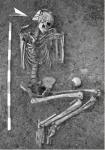Summary (English)
ARCHAEOLOGICAL EXPLORATIONS NEAR THE VILLAGE OF CHERNOMORETS (Petar Leshtakov – junior_1_bg@yahoo.com, Miroslav Klasnakov, Dimitar Nedev) The area of the settlement probably is over 0.08 – 0.1 ha. Five sondages were carried out on an area of 20 sq. m. Two layers from the Late Neolithic period (late 6th – early 5th millennia BC) were documented. Also, an area of 370 sq. m was explored. The cultural stratum is 0.70 – 1 m thick. The latest materials date to the Early Bronze Age (3500 – 1900 BC): sherds from dishes decorated with vertical lines in relief and Buckels on their mouths, and a ceramic vessel with horizontal handles. A stratum from the Bronze Age was not distinguished. An inhumation burial was discovered. The grave pit is oval and dug into the Chalcolithic stratum. The deceased is southwest – northeast oriented in a Hocker position, rested on back with legs to the left. The head is oriented to the southwest, facing to the north. The arms are twisted. A spherical ceramic vessel was found above the left hip. The burial probably dates to the Early Bronze Age. A Chalcolithic stratum, 30 – 45 cm in thickness, was explored. Piles of sherds and 13 pits were documented. Four pits had identical features and were used for grain storage. The most common pottery shapes are dishes with curved mouth, cylindrical-conical dishes and bowls. The pottery is predominantly with incised decoration. Sherds with painted decoration were attested. Pottery painted with graphite occurred rarely. The stratum could be generally dated to the Early Chalcolithic period (first half of the 5th millennium BC). Pieces of copper ore were found along with burned sherds with adhering pieces of ore, which testifies to metal production. The exploration reached the Neolithic stratum. Separate structures related to Karanovo III – IV and IV periods were explored in some sectors.
- Petar Leshtakov - Archaeological Institute with Museum
- Miroslav Klasnakov - Regional Museum – Burgas
- Dimitar Nedev - Archaeological Museum in Sozopol
Director
Team
Research Body
- Archaeological Institute with Museum
- Archaeological Museum in Sozopol
- Regional Museum – Burgas






![Download [PDF]](/excavation/skins/fasti/images/results/download_sml.png)